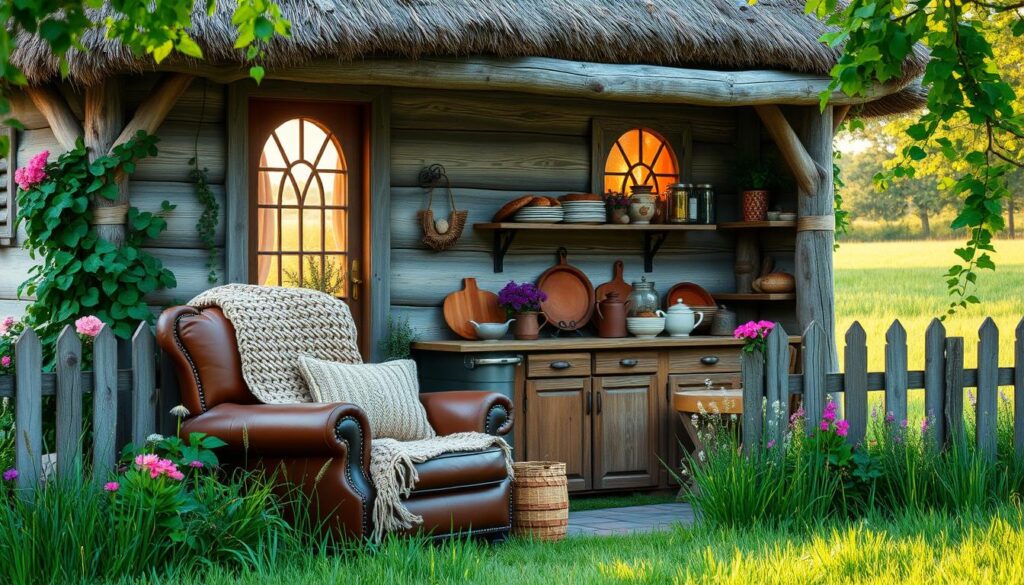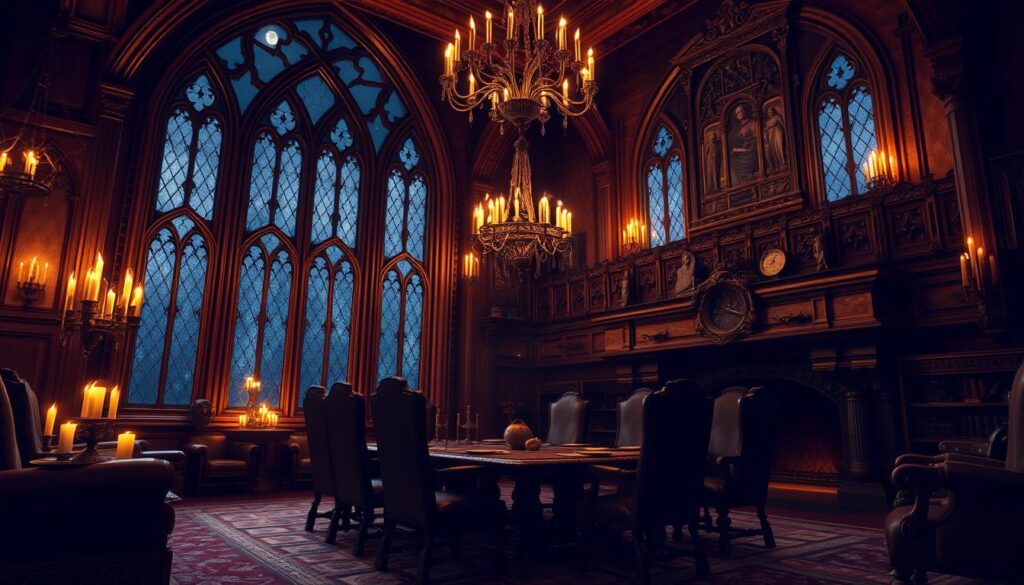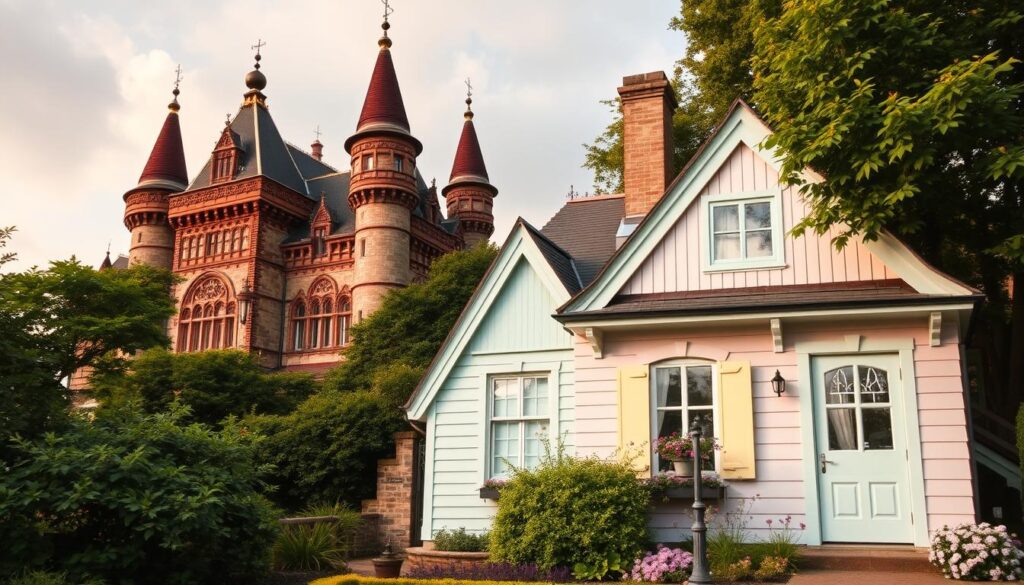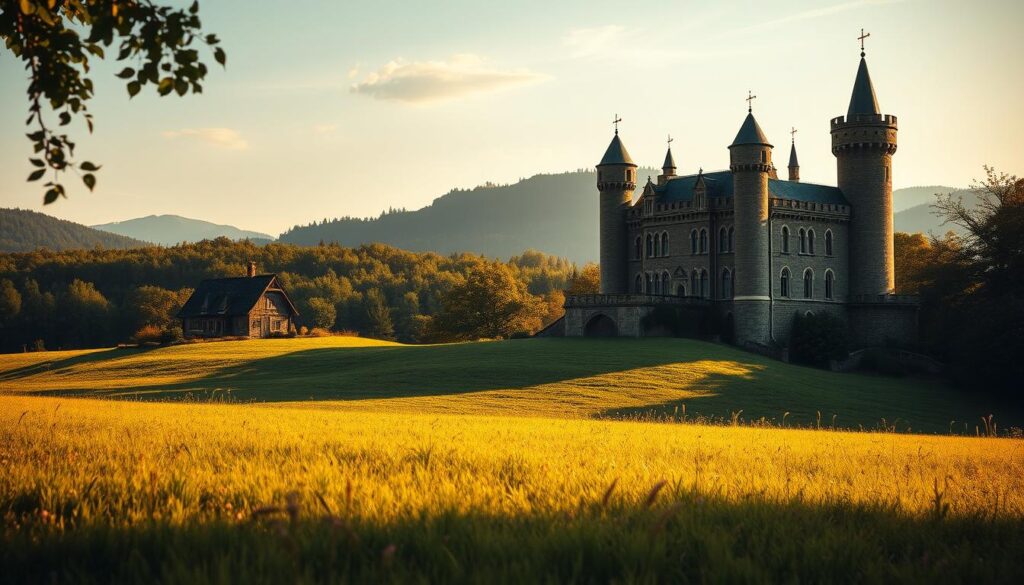Design trends evolve fast, and social media plays a huge role in shaping them. While the cozy charm of cottagecore dominated recent years, a new aesthetic is rising—castlecore. This medieval-inspired movement blends fantasy and luxury, offering a dramatic twist on rustic living.
Pinterest’s 2025 trend report highlights this shift, predicting castlecore as a major design influence. Unlike the pastoral simplicity of its predecessor, this trend embraces rich textures, deep colors, and grand architectural elements. It’s not just about homes; it’s a lifestyle shift.
Gen Z’s love for opulence and storytelling fuels the change. Platforms like TikTok and Instagram amplify these trends, making them spread faster than ever. From dark wood furnishings to stained glass accents, castlecore redefines modern interiors with a touch of fairy-tale magic.
Key Takeaways
- Castlecore is gaining momentum as a bold alternative to cottagecore.
- Pinterest forecasts it as a leading aesthetic for 2025.
- Medieval-inspired details and luxury define this trend.
- Social media accelerates its popularity among younger generations.
- The style focuses on drama, rich textures, and fantasy elements.
What Is Cottagecore? The Cozy Aesthetic Defined
Born from nostalgia and a love for pastoral beauty, cottagecore blends vintage charm with modern comfort. This aesthetic romanticizes countryside living, weaving together floral patterns, handmade crafts, and the warmth of simpler times.

Origins and Key Features
First dubbed “grandmacore” on Tumblr in 2018, the trend draws inspiration from European pastoral art and 1960s back-to-the-land movements. Think open shelves stacked with mason jars, wildflower bouquets, and quilts stitched by hand.
Signature touches include:
- Gingham textiles and floral wallpaper
- Visible, lived-in clutter (like hanging copper pots)
- Natural materials—wood, linen, and stone
Marie Antoinette’s Hameau de la Reine, a rustic retreat at Versailles, mirrors this ideal. Unlike stark minimalism, cottagecore celebrates intentional imperfection.
Popularity During the Pandemic
When lockdowns hit, searches for cottagecore spiked 150% on Tumblr. People craved self-sufficiency—baking sourdough, gardening, and DIY projects. TikTok’s #cottagecore hashtag hit 7.8 billion views as users escaped into fantasy.
Brands like Doen and Batsheva fueled the trend with prairie dresses and earthy palettes. At its heart, cottagecore isn’t just a design trend—it’s a longing for connection to nature and slower rhythms.
What Is Castlecore? The Medieval-Inspired Trend
Dark academia meets Gothic romance in the latest design movement taking over social media. Castlecore blends medieval architecture with fantasy elements, creating spaces that feel like a page from a fairy tale. Think vaulted ceilings, wrought-iron chandeliers, and tapestries whispering stories of old.

Gothic Elegance and Romanticism
This trend draws from Dark Academia’s love for old libraries and Gothic cathedrals’ drama. Key materials include:
- Wrought iron: Bed frames, candle holders, and stair railings.
- Stained glass: Window panels or tabletop decor for color play.
- Stone textures: Exposed walls or faux finishes for rugged charm.
A subtrend called “sea witchery” adds aquatic hues—deep blues and greens—with siren motifs. Velvet drapes in emerald or sapphire complete the moody vibe.
Social Media’s Role in Its Rise
Platforms like TikTok amplify castlecore’s appeal. Hashtags like #DarkAcademia and #Castlecore rack up millions of views, showcasing reading nooks bathed in candlelight. Instagram accounts like @castlecore.aesthetic curate dreamy spaces with canopy beds and antique desks.
Wayfair reports a 320% spike in searches for “Gothic canopy beds” as Gen Z reinterprets history with sustainability—think upcycled wood and LED candles. Unlike fleeting trends like Regencycore, castlecore’s storytelling depth keeps it fresh.
Castlecore vs. Cottagecore: Design and Aesthetic Differences
Interior design lovers are torn between two captivating worlds—one soft and pastoral, the other bold and medieval. Each aesthetic creates distinct moods, from sunlit kitchens to candlelit libraries. Let’s break down their contrasts.
Color Palettes: Pastels vs. Moody Tones
Benjamin Moore reports that 73% of cottagecore homes use pastels like buttercream and sage. Think spring greens and blush pinks—colors that mimic wildflower meadows.
In contrast, castlecore leans into drama. Farrow & Ball’s “Hague Blue” and “Railings” dominate, with oxblood and charcoal adding depth. These hues evoke stone castles and twilight forests.

Textures and Materials: Floral vs. Stone
Cottagecore celebrates natural simplicity:
- Linen textiles and floral prints on curtains or upholstery.
- Light wood finishes for tables and shelves.
Castlecore opts for grandeur. Home Depot notes a 41% spike in stone veneer sales, paired with velvet drapes and damask fabrics. Wrought iron accents complete the look.
Space and Atmosphere: Clutter vs. Grandeur
Cozy nooks define cottagecore interiors. Open shelves display mason jars and quilts, inviting casual comfort.
Castlecore craves height and drama. Vaulted ceilings, stained glass, and candle sconces create a cinematic vibe. Even tableware reflects this—Anthropologie’s 2024 line offers rustic ceramics alongside Gothic goblets.
Netflix’s Bridgerton (pastel parlors) and The Witcher (shadowy halls) showcase these styles perfectly. Your choice depends on whether you prefer sunlight or candlelight.
The Cultural Roots and Appeal of Both Aesthetics
Behind every design movement lies a deeper cultural story—why we crave certain aesthetics at specific moments in time. Cottagecore and castlecore aren’t just about decor; they reflect our collective dreams, anxieties, and even economic realities.

Cottagecore’s Nostalgia for Rural Simplicity
Cottagecore taps into nostalgia for a slower, pastoral life. A 2023 Yale study found 68% of enthusiasts adopt it to cope with climate anxiety, seeking comfort in sustainable habits like gardening. This mirrors historic back-to-the-land movements, where urbanites fled to the countryside for self-sufficiency.
Key drivers include:
- Thriftability: Secondhand finds and DIY projects dominate.
- LGBTQ+ safe spaces: Many use it to reclaim nature-centric identities.
- Historical realism: Think Magnolia Network’s Fixer to Fabulous restoring farmhouses.
“Cottagecore isn’t just a trend—it’s a lifeline for those overwhelmed by modern chaos.”
Castlecore’s Fantasy and Escapism
Castlecore leans into fantasy, offering an escape into mythic worlds. Its rise parallels Dungeons & Dragons’ popularity—41% of players redecorate with Gothic arches or velvet drapes. Dark academia communities blend it with “cottagegoth,” mixing medieval art with moody palettes.
Why it resonates:
- Investment pieces: Antique desks or stained glass become heirlooms.
- BookTok influence: A Court of Thorns and Roses inspires canopy beds.
- Luxury as rebellion: Gen Z rejects minimalism for drama.
Both trends reveal a shared hunger for meaning—whether through earthy comfort or enchanted grandeur.
Why Castlecore Is Dominating in 2025
The future of home decor is shifting toward bold, story-rich spaces. Pinterest’s 290% spike in “medieval bedroom” searches signals a craving for grandeur—proof that *interior design* is leaving minimalism behind.

Pinterest’s Prediction and Influencer Impact
Social media fuels this *trend*. Athena Calderone’s CB2 collab sold out Gothic arches in hours, while #DarkAcademia racks up 4.2M TikTok views. Gen Z spends 37% more on chandeliers, per Lighting Plus.
“Castlecore isn’t just decor—it’s wearable fantasy. We’re designing *homes* like novel settings.”
Shifting Preferences Toward Drama and Luxury
Post-pandemic, muted tones feel stale. Versace Home’s new heraldic rugs and Zillow’s 2.3% value boost for “dramatic entryways” prove opulence pays off. HBO’s House of the Dragon doubled searches for iron candleholders.
| Feature | Cottagecore (2020–2023) | Castlecore (2024–2025) |
|---|---|---|
| Color Palette | Pastels (sage, blush) | Moody (oxblood, charcoal) |
| Key Material | Linen, light wood | Stone, velvet, wrought iron |
| Mood | Cozy, casual | Cinematic, immersive |
This *aesthetic* thrives on adaptability—modern *homes* mix arched doorways with smart lighting. Unlike fleeting *trends*, it merges history with *future*-forward *interior design*.
For those torn between *styles*, explore how comfort-focused spaces bridge rustic and luxurious living.
Conclusion: Which Aesthetic Will You Choose?
Your home reflects your personality—whether you lean toward cozy nostalgia or dramatic fantasy. Budget and space matter too. A studio apartment might suit lighter design touches, while loft spaces can embrace grandeur.
Can’t decide? Blend both! Try “Cottage Castlecore” with floral tapestries against stone-textured walls. Etsy’s vintage finds and Farrow & Ball’s moody paints help craft your dream space.
Looking ahead, 2026 trends hint at oceanic themes merging rustic and medieval elements. For now, take Pinterest’s aesthetic quiz or share your DIY projects using #CottageCore2025 and #CastleCoreRevival.
Remember: comfort and personal style outweigh strict trends. Your space should tell your story—pastoral charm or fairy-tale future.

